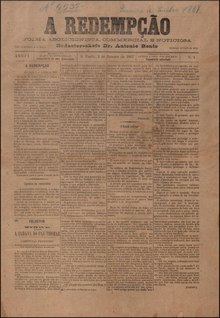Black press in Brazil
[1] During this long period, the press was prohibited from operating by order of the Portuguese Crown,[2] but pamphlets, leaflets, and books circulated widely clandestinely, often addressing demands.
There are records that in 1789, when Bahian blacks promoted the Revolta dos Búzios, leaflets and manifestos were posted on houses and walls as a way to rally the insurgents and communicate to society their rejection of social inequalities and racial discrimination.
[1] According to Ana Magalhães Pinto, these early black newspapers did not focus on the problem of slavery but shared an idea, inspired by liberalism and Enlightenment, that individual talents and virtues, not skin color, should be the guarantee of equality and democracy.
O Homem stood out from its predecessors due to a broader and deeper approach to issues relevant to black people, indicating that during this long period without press, there was a significant gain in experiences and knowledge to establish stronger arguments against slavery and discrimination, but like the others, it had a short life.
[2] There were also 31 leaflets and pamphlets exclusively dedicated to abolitionism between 1871 and 1888, the year of the abolition of slavery, such as Cidade do Rio by José do Patrocínio, and Gazeta da Tarde by Ferreira de Meneses, although not all of them were edited by black people but also by white sympathizers of the cause.
However, although these rights were secured by law, in practice, they would be constantly violated, and the deceptive idea of racial democracy allegedly implemented gained strength, increasing the feeling among black people that the official promises once again had been empty and that their situation, instead of improving, was worsening.
[9] Indeed, at that time, a mass of low-skilled European immigrants was entering the country, competing more or less for the same job market,[4][10] many people in the countryside lost their place to live and were pushed into urban favelas without any structure or support,[11] a law in 1890 banned the entry of any black person into the country, a historiographical discourse sought to erase the contribution of black people to the nation's growth—both in purely economic and cultural terms—and population whitening theories gained new momentum, extending their influence into the early decades of the 20th century.
[15] Others provided space for the publication of poems, chronicles, apologues, epigrams, satires, news of general interest, protests against prejudice, articles on the reconstruction of lost cultural identity and the integration of blacks into Brazilian society, advocating the removal of a marginalized situation.
[16] At the same time, efforts were made to stimulate the formation of a proud consciousness of Negritude, encouraging the cultivation of self-esteem, memory, African ancestral culture, and traditions, warning against the danger of seduction by ideologies of population whitening, and promoting biographies of black leaders from Brazil and other countries as examples for others to follow.
The movement resurfaced in 1945 with the launch of the periodical Alvorada, linked to the Association of Brazilian Blacks, soon followed by the newspapers O Novo Horizonte (1946), Senzala (1946), União (1947), Quilombo (1948), Cruzada Cultural (1950), Redenção (1950), A Voz da Negritude (1952), Notícias de Ébano (1957), O Mutirão (1958), Níger (1960), among others, published in various states,[2][3][10] seeking to unite scattered activists and demand greater participation in the economy, more space in society, and more weight in political decisions.
[3] A new period of repression of activism and the press began in 1964 with the establishment of the military dictatorship, when censorship and ideological warfare were imposed, and dozens of black leaders were persecuted, arrested, exiled, tortured, or killed for their involvement in advocacy movements, considered a threat to national security and to the official propaganda of a supposedly racism-free country, where it was claimed that a racial democracy prevailed, which, nevertheless, was entirely rhetorical and fictitious.
[20] The Tição served as an encouragement for the launch of other publications,[4] such as the newspaper Sinba (1977) and the collection Negrice (1977),[18] and according to Oliveira Silveira, with "careful presentation, good layout, and content involving history, debates on racism, social, political, and cultural issues in general, [the Tição] reaffirmed the possibility of a vibrant, renewed, serious, and rich black press with diverse approaches, themes, and depth.
[1] From the 1980s onward, the focus of the black press changed: while it continued to denounce racism and inequality, the previous project of social inclusion through education, work, and puritan ethics was generally abandoned.
Instead, there was a greater emphasis on deconstructing hegemonic discourses and deepening the understanding of all issues related to the black experience with a more solid scientific, sociological, and historical foundation.
This was supported by the example of struggles against colonialism and racial discrimination in African countries, as well as the rapid growth of academic studies, NGOs, and university research centers focused on black culture and history in Brazil.
[25] In 2018, a group of 38 19th-century black and abolitionist newspapers and leaflets were included in the Brazilian section of the Memory of the World Register, promoted by UNESCO, and are available for online consultation on the website of the National Library.
They influenced the process of abolition of slavery decades before the signing of the Golden Law, signaling the triumph of civil society's pressures on the imperial State.




